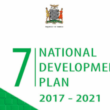On 21st June 2017, His Excellency President Edgar Lungu unveiled a Patriotic Front’s vision for the next five years: the 7th National Development Plan (7NDP). But is this an improved formula? Are NDPs solving development challenges or serving political productivity? In this feature, I offer a preliminary assessment of the 7NDP and what this means for development discourse in Zambia. In questioning the entire architecture of national development plans in Zambia, I make an argument that the main reason for optimism in the 7NDP is the evidence of new thinking that departs from sector-based planning to an integrated multi-sectoral approach. This feature hopes to generate an on-going public debate and analysis about development opportunities and challenges facing our country today.
Broadly speaking, actual achievements in erstwhile NDPs remain mixed and largely disappointing whilst being characterised, in rare occasions by brief positive moments. Planning was sectoral, with ministries almost always in constant battle to secure funding for completion of their activities. Sector divergences on government’s objectives and priorities was common plague, compounded by crucial disconnects in activities and poor institutional capacities. In most cases, and with serious budgetary constraints, it seemed almost heretical for ministries to collaborate and coordinate related activities. Others have argued that the past NDPs were actually a time and resources wasted, serving as distraction from more central development challenges facing the country.
The unprecedently detailed 7NDP “departs from sectoral-based planning to an integrated multi-sectoral development approach.” The centrality in the government’s thinking towards a coordinated, harmonised and cooperative approach lies in the complex and interrelated challenges for development facing Zambians today. It is easy to see that the way mining plays out for instance can impact water resources that in turn affect agriculture activities upstream which again compete with energy – the so-called nexus thinking in water, food and energy. Agriculture accounts for 70% of the freshwater consumption worldwide. The nexus thinking recognises that any solution for one problem, for example water, must equally consider the other two. The centrality of the 7NDP points to the fact that development efforts are integrated, amalgamating mutually supporting activities for wider impacts.
The 7NDP aims to create a diversified and resilient economy for sustained growth and social economic transformation driven, among others, by agriculture. Recently, I made a presentation in Sheffield UK at a conference – “Africa in the era of Sustainable Development Goals – in which I argued that “the politics of leaving no one behind” as enshrined in the SDGs are still the politics of agriculture and of the rural. The Zambia’s 7NDP underpins this argument, appreciating the diverse impacts agriculture has on employment, incomes, food security and economic growth. However, it remains yet to be seen how this plays out in reality but suffice to say that 60% of Zambians are engaged in agriculture and 40% are rural based. Re-organising this sector will be crucial in realising most if not all elements of SDGs and those aspirations under the Vision 2030, underpinning inclusive and equitable development. From FISP, to extension services and market linkages including the unfortunate homegenisation of crops in all regions in Zambia are all areas that require concerted efforts. The 7NDP addresses most of these elements but implementation will be key. Meanwhile the re-organising tenure relations in rural areas as domestic and foreign actors exploit customary and cheap land requires serious attention. To fundamentally reduce poverty and ensure wellbeing for rural dwellers, the way land is made available, accessed and worked require a solid policy position particularly in the now era of land grabbing.
I now move to Zambia’s problematic growth. Growing at impressive average of 5.8% (2000-2005) and 6.9% (2006-2015), Zambia faces two related problems. The first is that the growth is extractivist, with mining contribution increasing from 4.2% to 14.6% between 2000 and 2014, making the economy extremely vulnerable to global commodity fluctuations in prices. A recent 28% fall in commodity prices (2007-2009) saw a corresponding drop in FDI of 47%. Second is the longstanding fallacy of trickle-down economics which ensures that the country continues to register higher levels of poverty. Despite making progress in reducing incidences of poverty, rates remain unacceptably high with 8.5 million Zambians living in poverty, 3.5 million of which fall in extreme poverty. As noted in the 7NDP, these challenges are candidates for a diversified economic base. Historical growth success has taken place outside broad-based changes in sectors such as agriculture. Many agree that the diversification song in Zambia has become monotonous. The 7NDP induces renewed hope but it remains to be seen how the government will incentivise diversification away from mining. Implementation and coordination of activities will remain crucial. The suggested regional comparative and competitive advantages would be a perfect launch pad for diversified agriculture and economy.
This brings me to the issue of poverty and unemployment. First lies a recognition that mining is less labour intensive. The growth of the informal sector in Zambia comes alongside precarious working conditions and poor wages. Given the youthful demographic “dividend” at the heart of Zambia, unemployment will require immediate attention. That growth has been narrow raises calls for: “inclusive development without leaving anyone behind.” Whilst the 7NDP notes unemployment and poverty as challenges, incentive programs for entrepreneurial ventures for youths have largely been missing. A critical examination of the Citizen Economic Empowerment Fund exposes coordination deficits with its success remaining highly debatable. Incentive programs in agriculture and elsewhere can provide a push for broad-based employment creation and poverty reduction. The desire to modernise agriculture can start with graduates that are willing to start-out in agriculture which in turn can provide a push for employment creation. The 7NDP carefully considers reviving sectors such as coffee, fruit and cotton sub-sectors but this must be private sector driven as opposed to government dominated.
This links to research and development as systems of innovation, feeding into the role of higher learning education. Past efforts in NDPs focused on enrolment, access and completion rates for primary and secondary school. Whilst focusing on infrastructure development and increased access to University, Zambia neglected the quality of training and increasing industry relevance of the sort of education provided. The 7NDP records that by 2014, 12% of the employed had no education (mostly agriculture) whilst 40% had primary and secondary education respectively. Only 5% of the employed had tertiary education. TEVET enrolment is important but insufficient to guarantee quality. At the heart of success by the Newly Industrialising Countries lies innovation and technology. The question is: Who is really thinking and innovating in Zambia? How can the country promote entrepreneurial culture? One feature that comes to my mind is a deficit in systems of national innovations and the 7NDP insufficiently places emphasis on these elements. Within this perspective, it is inescapable to talk about the role of universities in research, development and innovations.
Universities have been said to sit at the forefront of Africa’s renewal and revitalisation but as Ihron Rensburg, president of the University of Johannesburg and the founding host of the Africa summit notes: “Our challenge is to nurture universities with diverse missions and to contribute magnificently towards Africa’s high skilled people, research and innovation needs.” Zambia’s expansion of higher education has been accompanied by what others have described as the private, for-profit universities. This refers to higher education institutions operated by private and profit seeking businesses or entrepreneurs but these come with their own challenges for the quality of training, research and development. As Adebayo Olukoshi (Director of the United Nations’ African Institute for Economic Development and Planning) warns that the transition and growth of the private sector Universities was eroding universities’ role in the advancement of the continent: “The essence of the university, Olukoshi argued, “rests more in the promotion of public purpose and not of private gain”, and rediscovering this mission will enable higher education to reclaim its rightful role in “the mobilisation of the citizenship which we require for the renaissance of the continent.” Whilst bringing ethical and moral questions around commoditisation of education – what the Minister of Higher Education Prof. Nkandu Luo calls “making business out of education” – the way research and systems of innovations play out will determine not only innovations and entrepreneurial minds but also diversification and employment creation. Zambia should occupy itself with producing a cohort of thinking and innovating graduates and its high time universities repositioned themselves in the country.
This takes me to a final element of what the plan says is transformation towards development. Whilst past NDPs were deeply introverted, central to the 7NDP’s theory of change lies the promotion of citizenship participation in the development of the plan, reflective of the need for combined efforts in addressing common challenges. Culture, values, attitudes and behavioural patterns have been cited in the 7NDP as being retrogressive, making it difficult to cultivate a positive Zambian identity. Reforming our institutions, the way service is delivered and attitudes at the heart of the bureaucracy are vital in achieving development goals. Attempts aimed at decentralisation will be futile if these attitudes remain docile and backward.
In sum, this is not a comprehensive analysis of the 7NDP. However, our preliminary assessment show that 158 paged 7NDP places a challenge not only the bureaucratic structure but to all Zambians, warning about the dangers of the business as usual. It demands that everyone reconsiders their beliefs, position and contribution to the country. The way programs will be rolled out, resources expended and managed and commitment from each Zambian will be crucial to achieving common aspirations. It will determine whether the plan is new formula. For now, the main optimism in the 7NDP lies in the evidence of new thinking and this I argue is its main thrust.












